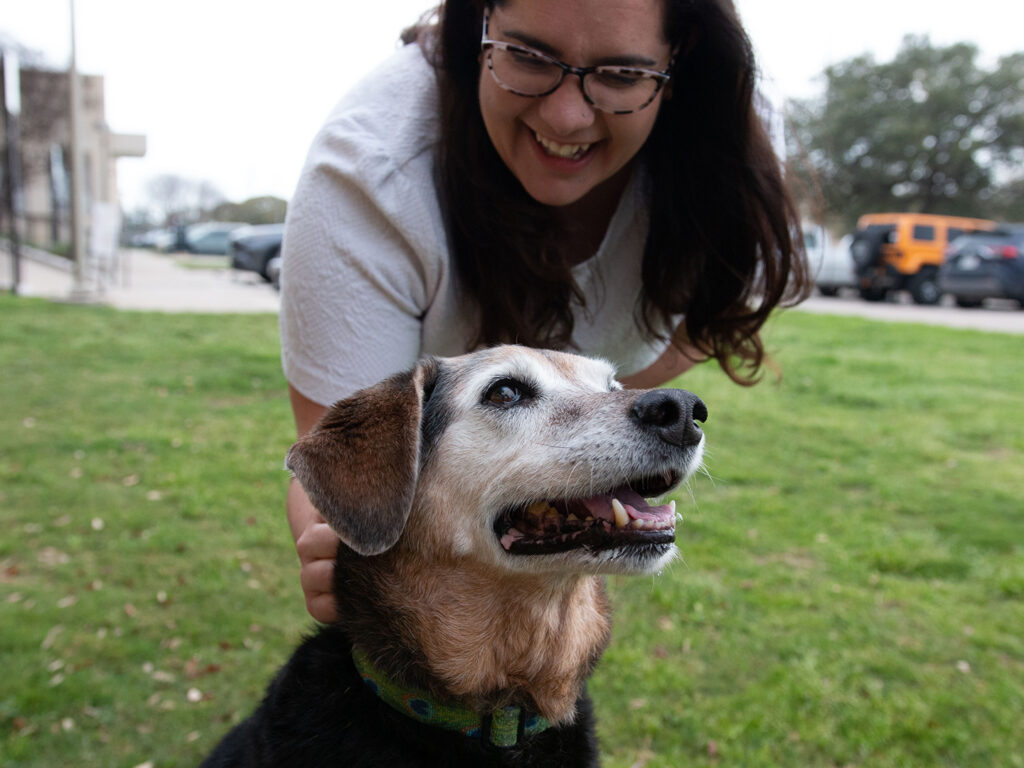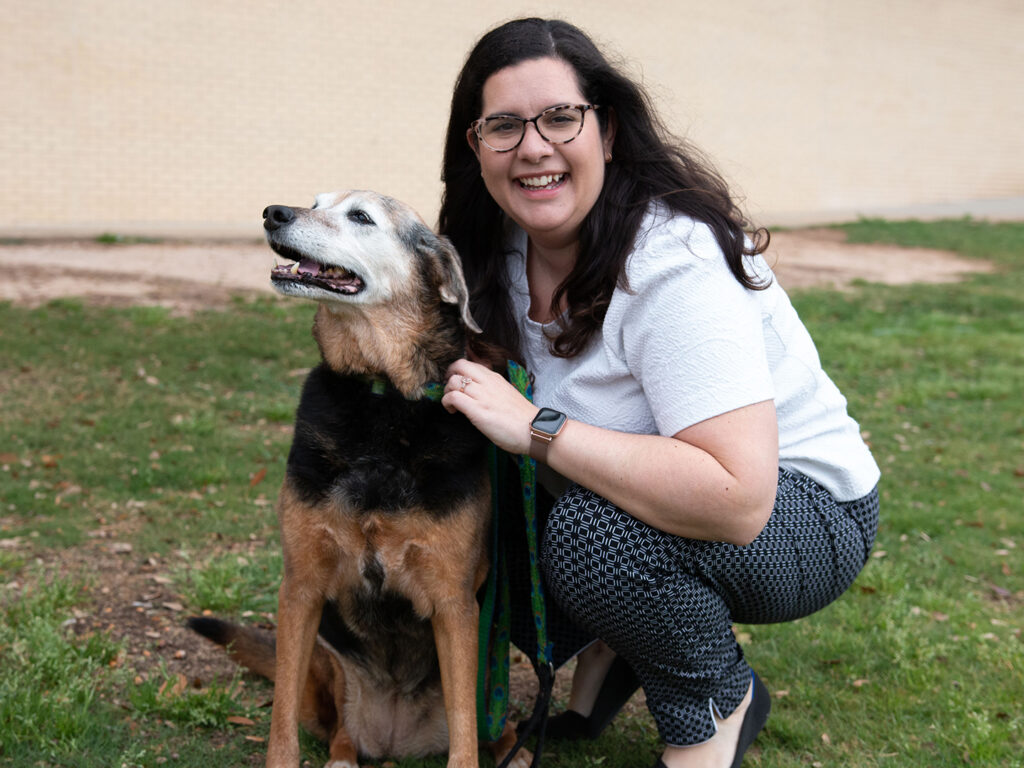Texas A&M Veterinary Oncology Team Helps Blue BTHO Cancer
Story by Megan Myers, VMBS Communications

Blue, a mixed-breed dog, has called multiple academic institutions home as she has traveled the country alongside her owner, Dr. Meriam Saleh.
“She has been with me at the University of Tennessee for my undergrad, Virginia Tech for my Ph.D., Oklahoma State for my postdoc, and now she’s an Aggie,” Saleh said. “She’s my little academic buddy, and I like to say that she has her ‘dogtorate,’ too.”
Since 2021, the pair have been at the Texas A&M School of Veterinary Medicine & Biomedical Sciences, where Saleh works as a clinical assistant professor.
As fate would have it, Texas A&M, home to one of the best veterinary cancer treatment centers in the country, was exactly where they needed to be.
Saleh first met Blue in 2011, when Saleh was studying animal science in Tennessee.
“Blue’s original owner got a job in Africa and asked me to keep her for three months while he was out of the country. She stayed at my house and I fell in love with her, and I was so sad when the three months were over,” Saleh said.
Fortunately for Saleh, the friend’s temporary job turned into a permanent one and Blue became hers to keep.
As the years went by, Blue was always by Saleh’s side; she was there for every exam, every graduation, and every “first day.”
The pair had a small scare in 2016 when a small bump on Blue’s ear turned out to be a low-grade mast cell tumor, but a quick surgery took care of the problem and Blue was considered cured.
“They said to just keep an eye out for any more lumps and bumps, but because it was low-grade and they got clear margins, it was not a big deal,” Saleh said.
Six years later, however, Blue’s cancer returned. Saleh noticed a large red mass under the dog’s front left leg in March 2022, which their primary care veterinarian confirmed as another mast cell tumor.

Blue was then referred to the Texas A&M Small Animal Teaching Hospital’s (SATH) Oncology Service, where the tumor was discovered to be high-grade, which meant it would grow and spread more quickly than the original one.
According to Blue’s veterinary team, mast cell tumors are the most common type of skin tumors in dogs, but only 11-35% are high-grade. The high-grade status influenced their decision to surgically remove the tumor and then do a round of chemotherapy to kill any remaining cancer cells.
“That was hard news, but Blue’s veterinarians were so caring and empathetic,” Saleh said. “Blue loves coming to her oncology visits and she loves everyone in oncology. She runs from me to go greet Diorella (McGuire, a veterinary technician) and it makes me so happy that she’s happy and well cared for. It makes all the difference in the world.”
And that love isn’t one-way; Blue’s oncology team loves her back just as much.
“Blue stole my heart the very first time I met her,” McGuire said. “My favorite things about Blue are her eternal puppy spirit and her happy dances. She lights up the entire Oncology Service every time she visits. Blue and I have developed a powerful connection throughout her treatment.
“I like to think that this bond has helped to make Blue’s frequent visits to the hospital for treatments as enjoyable as possible,” McGuire continued. “No one would guess that Blue is coming in for chemotherapy by the way she confidently prances down the hallway. She will always hold a special place in my heart.”
After Blue completed her three months of chemotherapy, she was finally, once again, cancer free.
“I cannot rave about the oncology team here enough,” Saleh said. “When we finished chemo, they all signed Blue’s bandana and they rang the bell with us. They were happy, too, and that means a lot.”
Since then, Blue has returned to the SATH every three months for bloodwork, radiographs of her lungs, and aspirates of her liver and spleen to look for signs of metastasis. These locations, in addition to the skin, are where new mast cell tumors are most likely to form.
“I just make the most of every day and I consider all the time I have with her a gift,” Saleh said. “She’s happy and that really is all that matters to me.
“Blue has been a part of my life since college, through all my training to be a parasitologist with the goal of working at a veterinary school,” Saleh said. “It’s just really full circle that the place where I work and teach is also the best place in the world for her to get this kind of care. We’re just really lucky.”
###
For more information about the Texas A&M School of Veterinary Medicine & Biomedical Sciences, please visit our website at vetmed.tamu.edu or join us on Facebook, Instagram, and Twitter.
Contact Information: Jennifer Gauntt, Director of VMBS Communications, Texas A&M School of Veterinary Medicine & Biomedical Sciences, jgauntt@cvm.tamu.edu, 979-862-4216


